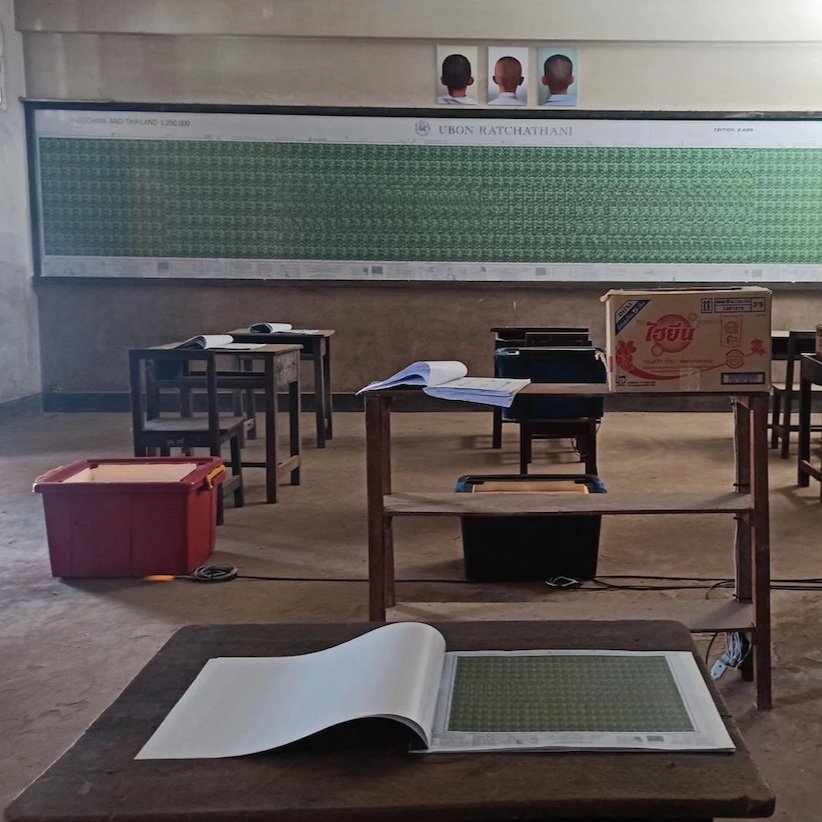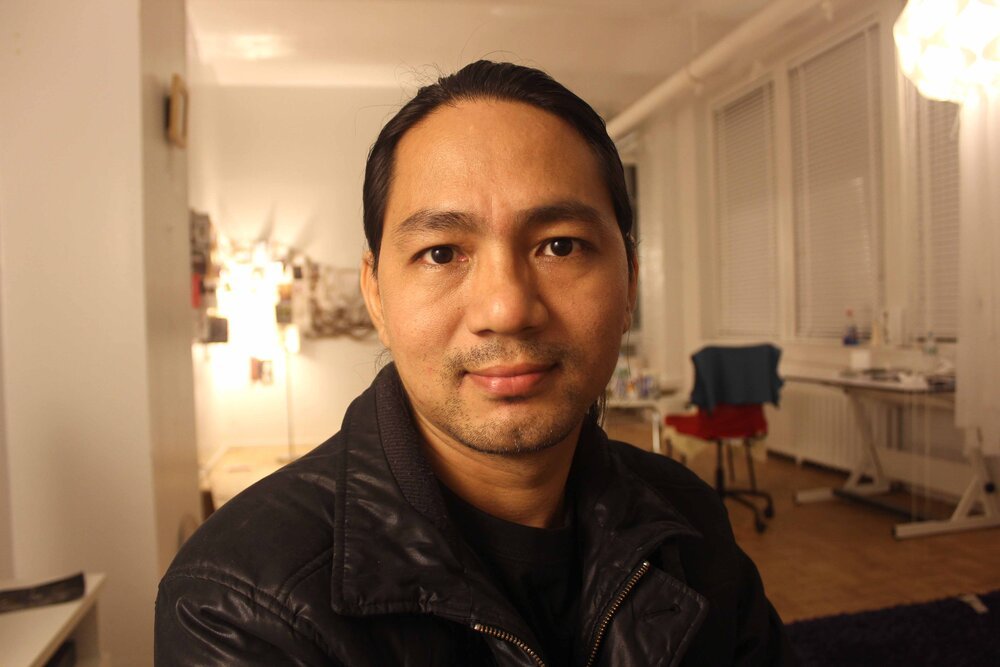Fresh Faces: Ngô Đình Bảo Châu
Unpacking ‘Towards Realist Socialisation’
By Arlette Quynh-Anh Tran
A&M's Fresh Faces is where we profile an emerging artist from the region every month and speak to them about how they kick-started their career, how they continue to sustain their practice and what drives them as artists. Read our profile on Vietnamese artist Ngô Đình Bảo Châu here.
Ngô Đình Bảo Châu. Image courtesy of the artist and KAAREM.
What did you study as a specialisation at Fine Art University in Saigon? Did it have any impact on your later artistic practice?
I majored in lacquer, focusing on traditional Vietnamese methods and techniques. The process of working with lacquer requires a lot of time and patience. After graduation, I made lacquer paintings occasionally, but not anymore. Since new ideas and materials always fascinate me, I have decided to choose freedom of expression over being tied to a material which I have not figured out how to transform yet.
However, I still reference the aesthetic of lacquered surfaces in my current practice, such as using craft techniques such as gold or silver leaf application or mosaic. My training in lacquer painting taught me to appreciate meticulous craftsmanship. Ordinary materials such as eggshells from hens or ducks can also become painting materials, and they are as beautiful as we can imagine.
Your class cohort is very special, as it is one of the very few still practising art. It includes yourself, Lang Do, Truong Cong Tung, Thao-Nguyen Phan, Pham Tran Viet Nam, Vo Tran Chau, and others. How do you see your friendship with them evolving through the years?
The Vietnamese artist community is relatively small, so I always think it is a blessing to have such connections. Like you mentioned, we grew up as fellow students into artists. To be honest, we often talk about life more than art whenever we have a chance to meet up. That said, friendship in art is about sharing and it motivates me to keep making works. My early exhibition opportunities were also self-organised by this group of friends. Over time, I gradually gained the confidence to follow the path of practising art.
Ngô Đình Bảo Châu, ‘Uniform – Wallpaper’ (detail), 2020, woodblock print, monoprint, stamping, stencil, acrylic, glitter, imitation gold leaf on cardboard, set of 40 prints, 60 x 80cm (each). Image courtesy of the artist and Galerie Quynh.
Lately, you have been interested in printmaking and experimenting with the paper pulp material. What led you to these materials and techniques?
The set of works titled ‘Uniform - Wallpaper’ in my solo exhibition is executed with printmaking techniques on ordinary paper, used to make every-day life products. This is in line with a specific direction I had for the show. Hence, you may notice that the materials used were highly mundane: velvet fabric for pillow covers, foam stuffing commonly used in pillows and mattresses, and cardboard for kitchen installations.
I am interested in propaganda posters and public infrastructures. Therefore, it was only natural and logical for me to use printing technology for this series. The paper used in ‘Uniform’ is rather thick and absorbent, and these qualities allowed me to display the work on the wall without frames. They come together to serve the function of a wallpaper.
What brings you most joy in the art making process?
I love when the ideas are formed, the “Eureka” moments and if a few days later I still think they are good ideas. I also love the stressful moments of setting up for the exhibition… every single second of it.
Have you ever had an idea that is too absurd, complicated or radical to make? If yes, do you insist on trying it or sketch it out to save for later?
I have a dream to display my work on public billboards. Apart from getting approval for the content of such billboards, a big budget is also another pre-condition because the rental is costly. Maybe in the near future, I will create my own series of billboards. Who knows? I guess I could create some kind of structure and call them billboards.
Your artworks often employ symbolism. What is one striking symbol that left the biggest impression on you?
It is the circle. When I started learning to draw, I was told that the sphere has the same shape no matter what angle you look at it. The displayed image is always a circle, which means that every point on the sphere is equal, like the Earth. Interesting, right?
Ngô Đình Bảo Châu, ‘Epaulette – Bench’, 2020, concrete, vegetable-tanned leather, wood, 51 x 190 x 85cm. Image courtesy of the artist and Galerie Quynh.
“When working with different materials, I am inspired by their newness and the fact that I do not yet know their properties. I have this thought that in the future, all my artworks can be put together to form a furniture showroom or a flea market: a diversity of styles, aesthetics and materials coexisting in one physical space but evoking different mental spaces.”
Ngô Đình Bảo Châu, ‘Layered Ego 1’ (detail), 2019, trucchigraphy on silk, 18 Truc Chi paintings, 580 x 100 cm (3 pieces) and 580 x 150cm (15 pieces). Image courtesy of the artist and Vietnam Trúc Chỉ Art.
I enjoyed reading your journal in New York during your residency at Apexart. ‘The Extracts’ series (2015-present) is your visual journal as well. Have you been journaling in both written and visual forms for a long time? What urged you to start this set of daily sketches in 2015?
Oh, it was indeed a beautiful month of my life. After my residency period, the Apexart teams told me I knew more about New York City than any of them. It shows how much I travelled around when I was there. The Apexart Journal, with its drawings and words, helped me to pick out new things from my own observations after each full day of activities.
Back in 2015, I did not practise art as much. Instead, I spent more time working as a freelancer for advertising agencies. These sketches were my way to keep the artistic flow. At first, I drew without a subject, taking from images gathered from news on the internet, or my imagination. Looking back on that period now, through the messy sketches, I can see the outline of an entire phase. For me, life is like a loop of events. I still remember I drew from a piece of news about the Ebola epidemic in Africa in 2015, and when I showed this drawing last year in 2020, another epidemic was taking place.
Ngô Đình Bảo Châu, ‘Everything Falls Down, The Flames Go Up – Twin Kitchens’, 2020, cardboard, paper, imitation silver leaf, emulsion paint, L-brackets, screws, LED lights, 200 x 650 x 180cm. Made in collaboration with artist Nguyen Duc Dat, architect Laurent Serpe. Image courtesy of the artist and Galerie Quynh.
In your solo exhibition ‘Towards Realist Socialisation’ (2020), your monumental work ‘Everything Falls Down, The Flames Go Up – Twin Kitchens’ (2020) deals humorously with a few concepts. The installation juxtaposes the modularisation of Western modern architect versus DIY craftsmanship; the idealisation of housework design for women versus useless paper model; and the permanence of artwork versus its performative burning threshold. How did you come up with the idea for this artwork?
With this exhibition, I had the overall picture very early on. The project was divided based on the concept of functional spaces in a house. During my research on socialism theories, I learned about this kitchen model through Arlette Tran, who is my long-time friend and also the exhibition curator. But only when I returned to the studio in Hue City and I saw ‘Art Forever’ that I knew how the kitchen in my conceptual house would look like. It was a series of cardboard furniture by artist Nguyen Duc Dat and architect Laurent Serpe, made at my studio during the holidays. Fortunately, they agreed to collaborate with me.
‘Everything Falls Down, The Flames Go Up – Twin Kitchens’ is a kitchen model reconstructed according to the famous Frankfurt Kitchen prototype structure designed by Margarete 'Grete' Schütte-Lihotzky. She was the first professionally trained female architect in the German-speaking region. The paradox here is that my installation is made of cardboard, which is only as valuable as votive paper. By using this fragile material, the work challenges social theories associated with the Frankfurt kitchen, the idea of monumentality, and our relationship with the dead.
In that exhibition, you also contemplate the idea of a home and its interiority. During this COVID lockdown when one has to stay at home for long, how has this idea shifted or reflected further?
People are trapped by the things they own, oppressed by invisible social constraints. This COVID lockdown is not the first time that I needed to stay at home for a long duration. However, during this period, I had the chance to observe my visibility in a specific space, along with the invisible social factors that shape the current version of myself. Those were the initial thoughts that led me to the idea of the exhibition. More broadly, the interiors refer to the daily routine and habits, and in the pandemic, our constant presence in the house further outlines the invisible elements: fear, belief, ambiguity... In general, people are fragile.
Could you share your favourite art space or gallery in your country? Why are you drawn to that space and what does it offer to you or your practice?
One is Galerie Quynh, where my first solo exhibition took place. Over the past two decades, Galerie Quynh has persistently shaped the contemporary art scene in Saigon. It was also the first art space I visited when I was a student, and my first exhibition was only possible thanks to the patience and trust from Ms. Quynh Pham. I am grateful for that.
The second and most important space is San Art House. This can be considered as the first professional art environment I attended. After my residency at San Art Laboratory, I was able to see my development as an artist.
What are your hopes for your own local art scene, and regionally?
I believe in all aspects of education, and I hope that art education in Vietnam can achieve more in the near future. The development of contemporary art in Vietnam today is the result of collective efforts from independent individuals and organisations. Unfortunately, the art university environment remains the same even after 10 years, when I was still a student. A fresher art scene can only emerge from more innovative and creative art education, even at smaller scales.















